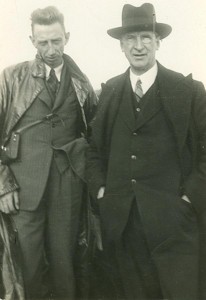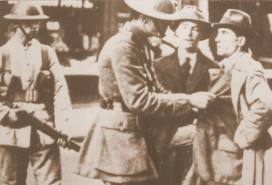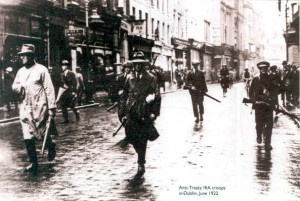Events in Terenure in the Irish War of Independence and Civil War

By John Dorney
Terenure village, in south Dublin, grew up in the 19th century after a road was driven west from neighbouring Rathgar.
By the early 1900s it was the terminus for a tram line and a substantial suburban settlement. From the 1860s it was a also the site of Terenure College, a school for upper middle class Catholics.
The village was largely affluent, but had also its share of all classes. Todd Andrews for example, a youthful IRA Volunteer in the years of Irish nationalist insurgency, spent his early years in Dublin’s tenements but his father and mother both ran their own small businesses meaning that by the time he joined the Volunteers in 1917 his family lived a comfortable life in suburban Terenure.
Like many other young men, Andrews joined the local company, based in Terenure and Rathfarnham of the Dublin Brigade in the years after the 1916 Rising.
‘Men of No Property’

Andrews remarked that in his E Company of 4th Battalion, ‘the men were men of no property. Except for what little furniture the few married men had accumulated … But they were all in regular employment even if their jobs were menial, very badly paid and insecure. None of them were destitute. They had a minimum of food, clothing and shelter.[1]
E Company of the Dublin Brigade 4th Battalion, like all IRA Volunteers around the country, took an Oath of Allegiance to Dail Eireann and the Republic in the autumn of 1919, in their case in Ballyboden library.[2] The oath administered by GHQ went, ‘I will support and defend the Irish Republic and the Government of Ireland, which is Dail Eireann, against all enemies, foreign and domestic’.[3]
Until after Bloody Sunday in November 1920, most IRA actions in Dublin were arms raids – as was for instance the raid in North King Street in which two British soldiers were killed and for which Kevin Barry was hanged. But most arms raids did not involve overt violence. Todd Andrews’ Company raided the local Big House in Terenure – Bushy Park House, owned by the Shaw family – for arms and took their shotguns and sporting rifles without resistance.[4]
It was not until late December 1920 that IRA GHQ really committed the Dublin Brigade, as opposed to the Squad and Intelligence Department, to the fight. What the young men in the companies were expected to do, especially from late 1920 on, was to meet weekly for ‘parades’, where they would collect arms from a ‘dump’ and to ‘patrol’ their company areas.
This resulted in an ambush of British forces in Terenure on January 29 1921.
Ambush on British troops in Terenure 29 January 1921

The ambush at Harold’s Cross Road Terenure took place at 7 pm of January 29, 1921. It was carried out by 26 IRA men from Dublin Brigade Fourth battalion, equipped with hand guns and home made grenades. Some, like Andrews were from E Company and others from G Company (Harold’s Cross). [5]
They noticed a military lorry, belonging to the Royal Berkshire Regiment, was parked outside the police station on Terenure Road North, opposite Elm Park Road.
Three separate IRA squads took up position on the corner of Eaton Road and further up at St Edna’s Road and at Kenilworth crossroads and when the lorry went past they fired.
IRA lieutenant Hugh O’Byrne of G Company was standing at the corner of Eaton Road ‘opposite the [RIC] barracks’ armed with a revolver and grenade. He fired one or two shots at the lorry at close range as it drove off but did not use the bomb as it was defective. [6]
C.S. ‘Todd’ Andrews took part in the ambush and left an account in his memoir ‘Dublin Made Me’. He says that his company OC FX Coughlan was in command of the ambush.
The troops had already been through a fire fight in Terenure village when they reached Andrews and at least seven other IRA men.
Andrews himself was standing at the Kenilworth cross roads when the lorry came past, with his friend Larry Kane. They both carried Webley revolvers.
According to Andrews, the troops were singing ‘I’m forever blowing bubbles’ and Kane shouted at them, ‘we’ll give you fucking bubbles’ as they opened fire with their revolvers. Two other men threw bombs at the truck, before the IRA men made their getaway, running down Rathgar Avenue. [7]
According to historian William Kautt’s account, there were 9 military casualties. [8]
The Irish Times reported on August 19, 1921 that two British soldiers claimed compensation for having been wounded in the ambush on January 29. They were Private W Preston and Private AF Goodchild of the Royal Berkshire Regiment. [9]
Reprisals
Joe Lawless was imprisoned in Arbour Hill at the time and his version of the ambush (below) is second hand.
This was an ambush of military forces in lorries by Dublin Brigade I.R.A. personnel at Terenure, in the course of which several bombs were exploded in the lorries filled with British troops and, numbers of these were killed and wounded. The date of this ambush is recorded as 29th January,1921.
Sometime that same evening a couple of the warder N.C.O.s who were quartered in the military barracks across the road (now Collins Barracks) told us all the gory details of what they had seen and heard in the barracks when they went to their tea. One fellow had apparently been in barracks when the lorries returned after the ambush, and his description of the state of blood and gore of the lorries left little to the imagination.
When the news of the action reached the Castle, which I suppose it did within twenty minutes or so of the opening of the attack, every Auxiliary in Dublin as well as other forces, sped towards the area and spent the day and night terrorising the inhabitants of the locality in the effort to locate any of the I.R.A. participants.
In short, the Auxiliaries, as was customary, terrorised the area in the aftermath of the ambush, breaking windows, firing shots at local business and beating up suspects. [10]
The Irish Times reported on April 21, 1921 that a civilian John Doody a dairyman, was shot dead during the incident at Harold’s Cross Road, on January 29. It is not clear by which side. His mother Anne Doody was awarded £1,500 compensation. Which probably indicates that British state forces (military of police) were responsible.
Todd Andrews’ account backs this up as he says that as they were getting away towards Brighton Road, ‘we passed a civilian who had been hit by the indiscriminate fire of the British soldiers’.
Truce and split
The ambush in January 1921 was the only large scale engagement in Terenure during the War of Independence, though raids, shootings and arrests went on until the Truce of July 11, 1921.
The initial reaction among the IRA in Dublin to the Truce was one of relief. Todd Andrews, who had been interned since January 1921 escaped from a military camp at Newbridge and made his way back to the city with the aid of sympathisers in Kildare.
Back in south Dublin he found that he and his comrades were suddenly popular. The Squad and ASU men established a training camp in the remote Glenasmole valley in the Dublin Mountains.
The euphoric period of the Truce did not last, however. Fourth Battalion was split roughly down the middle by the Anglo-Irish Treaty. In July 1921 it had a paper strength of 934 and by the time the Civil War began on June 28, 1922, its anti-Treaty remnants was down to 451 men.[11]
E Company in the Terenure/Rathfarnham area, however, under the influence of its commander Francis X Coughlan, went almost entirely pro-Treaty.
Fire fight in the Civil War on June 30/July 1 1922

Terenure village became a battleground at the very start of the Civil War and saw a fire fight between pro and anti-Treaty factions on June 30, 1922.
A Free State (pro-Treaty) report on June 28, 1922 stated that as well as the strongholds at the Four Courts and O’Connell Street, which saw most of the fighting in Dublin, posts had been attacked by the anti-Treaty IRA in Dolphins Barn, Rathfarnham police barracks and at Vaughan’s pub in Terenure. [12]
It is hard to get details on what exactly happened there, however the action can be pieced together from IRA pension applications. For example, one anti-Treaty IRA member Patrick O’Connor stated that he was involved in the armed attack on the Free State military post in Terenure, on either June 30 or July 1, 1922. [13] According to Hugh O’Byrne there were two companies of anti-Treaty IRA men involved in the attack on the Free State post at Vaughan’s, which would mean about 50 men. [14]
Kevin O’Carroll (who had also taken part in the January 29 1921 ambush above) stated that he and others attacked the Free State military post at Vaughan’s Pub with rifle fire from the tram sheds – where Aldi supermarket in Terenure is today. The attack lasted for about half an hour. [15]
Padraig O’Broin says that as well as local anti-Treaty IRA men, about 20 Irish Citizen Army men were involved in the attack on Vaughan’s, most of whom were arrested not long afterwards in the mountains. [16]
It is not clear whether there any casualties on either side or among civilians during the gun battle. Most of the anti-Treaty fighters got away towards the mountains, also firing on Rathfarnham barracks on the way. They had another fight with Free State troops tat Glenasmole, beyond Tallaght, after which most of them went on the run or were arrested.
Mine attack 26 January 1923

There was one other incident of note in the Terenure area in the Civil War, albeit a little bit outside the village. An anti-Treaty IRA mine attack on 26 January on the Templeogue Road, opposite Terenure College, destroyed a National Army (Free State) armoured car. Two bombs were placed in petrol tins in a manhole and detonated by an electric cable fifty yards away.[17]
The bombs, which left a ‘large crater’ on the road, badly injured three soldiers; the driver was blown thirty yards and a Lieutenant Confery had his ‘mouth blown away’. Two other soldiers were slightly wounded as were two civilian passersby.[18]
FX Coughlan the erstwhile commander of E Company attempted to broker a truce during the Civil War, but to no avail. He also tried to have his old friend Todd Andrews from Terenure released from imprisonment for Christmas 1923.
Todd Andrews emerged from internment by the Free State in late 1923 ‘with my health unimpaired but with a mind ineffaceably scarred by bitterness’. He made his way from the Curragh to his father’s office in Capel street, where he got ‘the tram far home to Terenure’, to begin life again in a new independent Ireland.[19]
References
[1] Andrews, Dublin Made Me, p113
[2] Andrews, Dublin Made Me, p120
[3] IRA General Orders, Mulcahy Papers UCD P7/A/45
[4] Andrews, Dublin Made Me, p121 Joseph O’Connor BMH
[5] Hugh Byrne’s Military Pension statement is here.
[6] Hugh Byrne’s Military Pension statement is here.
[7] Andrews, (p.174-175).
[8] According to William Kautt’s Ambushes and Armour, the Irish Rebellion 1919-21, (p.197-201)
[9] Irish Times, April 19, 1921
[11] http://mspcsearch.militaryarchives.ie/detail.aspx?parentpriref=
[12] Richard Mulcahy Papers UCD P7/B/40).
[13] Patrick O’Connor’s pension statement where he discusses this is here).
[14] Hugh O’Byrne MSP
[15] Kevin O’Carroll Pension is here)
[16] (Padraig O’Broin Statement here)
[17] IRA Chief of Staff General Orders 2/2/1923, Twomey Papers UCD P69/2.
[18] National Army Intelligence Reports Dublin Military Archive, CW/OPS/07/016.
[19] Andrews p 326